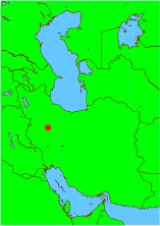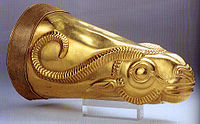
Ecbatana
Encyclopedia


Astyages
Astyages Astyages Astyages (spelled by Herodotus as Ἀστυάγης - Astyages; by Ctesias as Astyigas; by Diodorus as Aspadas; Akkadian: Ištumegu, was the last king of the Median Empire, r...
(Istuvegü), which was taken by the Persian emperor Cyrus the Great
Cyrus the Great
Cyrus II of Persia , commonly known as Cyrus the Great, also known as Cyrus the Elder, was the founder of the Achaemenid Empire. Under his rule, the empire embraced all the previous civilized states of the ancient Near East, expanded vastly and eventually conquered most of Southwest Asia and much...
in the sixth year of Nabonidus (549 BC).
Under the Persian kings, Ecbatana, situated at the foot of Mount Alvand, became a summer residence. Later, it became the capital of the Parthia
Parthian Empire
The Parthian Empire , also known as the Arsacid Empire , was a major Iranian political and cultural power in ancient Persia...
n kings, at which time it became their main mint, producing drachm, tetradrachm, and assorted bronze
Bronze
Bronze is a metal alloy consisting primarily of copper, usually with tin as the main additive. It is hard and brittle, and it was particularly significant in antiquity, so much so that the Bronze Age was named after the metal...
denominations. It is also mentioned in the Hebrew Bible
Hebrew Bible
The Hebrew Bible is a term used by biblical scholars outside of Judaism to refer to the Tanakh , a canonical collection of Jewish texts, and the common textual antecedent of the several canonical editions of the Christian Old Testament...
(Ezra
Book of Ezra
The Book of Ezra is a book of the Hebrew Bible. Originally combined with the Book of Nehemiah in a single book of Ezra-Nehemiah, the two became separated in the early centuries of the Christian era...
6.2) under the name Achmetha (also spelled Ahmetha, e.g. JTS Bible).
Ecbatana/Hamedan (Iran) is not to be confused with Ecbatana/Hamath (Syria)
Hama
Hama is a city on the banks of the Orontes River in west-central Syria north of Damascus. It is the provincial capital of the Hama Governorate. Hama is the fourth-largest city in Syria—behind Aleppo, Damascus, and Homs—with a population of 696,863...
where Herodotus claims that Cambyses II died.
In 330 BC, Ecbatana was also the site of the murder of the Macedon
Macedon
Macedonia or Macedon was an ancient kingdom, centered in the northeastern part of the Greek peninsula, bordered by Epirus to the west, Paeonia to the north, the region of Thrace to the east and Thessaly to the south....
ian Greek General Parmenio (or Parmenion
Parmenion
Parmenion was a Macedonian general in the service of Philip II of Macedon and Alexander the Great, murdered on a suspected false charge of treason....
) under the order of Alexander the Great.
Archaeology
Ecbatana was first excavated in 1913 by Charles Fossey.Another excavation was made in 1971.
Controversies
The Greeks supposed it to be the capital of MediaMedes
The MedesThe Medes...
, and ascribed its foundation to Deioces
Deioces
Deioces, Diyako or Deiokes was the first king of the Medes according to Herodotus. In the late 8th century BC there was a Daiukku or Dayukku who was a Mannaean provincial governor...
(the Daiukku of the cuneiform inscriptions), who is said to have surrounded his palace in it with seven concentric walls of different colours. In the fifth century B.C., Herodotus
Herodotus
Herodotus was an ancient Greek historian who was born in Halicarnassus, Caria and lived in the 5th century BC . He has been called the "Father of History", and was the first historian known to collect his materials systematically, test their accuracy to a certain extent and arrange them in a...
wrote of Ecbatana:
"The Medes built the city now called Ecbatana, the walls of which are of great size and strength, rising in circles one within the other. The plan of the place is, that each of the walls should out-top the one beyond it by the battlements. The nature of the ground, which is a gentle hill, favors this arrangements in some degree but it is mainly effected by art. The number of the circles is seven, the royal palace and the treasuries standing within the last. The circuit of the outer wall is very nearly the same with that of Athens. On this wall the battlements are white, of the next black, of the third scarlet, of the fourth blue, the fifth orange; all these colors with paint. The last two have their battlements coated respectively with silver and gold. All these fortifications Deioces had caused to be raised for himself and his own palace."
However, there are problems with this association. So far, there is no evidence of Median existence in Hagmatana hill prior to the Parthian era afterwards. Similarly, Assyria
Assyria
Assyria was a Semitic Akkadian kingdom, extant as a nation state from the mid–23rd century BC to 608 BC centred on the Upper Tigris river, in northern Mesopotamia , that came to rule regional empires a number of times through history. It was named for its original capital, the ancient city of Assur...
n sources never mention Hagmatana/Ecbatana. Some scholars think that the problem can be resolved by identifying the Ecbatana/Hagmatana mentioned in later Greek and Achaemenid sources with the Sagbita/Sagbat frequently mentioned in Assyrian texts, since the Indo-Iranian
Indo-Iranian languages
The Indo-Iranian language group constitutes the easternmost extant branch of the Indo-European family of languages. It consists of three language groups: the Indo-Aryan, Iranian and Nuristani...
sound /s/ turned into /h/ in many Iranian languages
Iranian languages
The Iranian languages form a subfamily of the Indo-Iranian languages which in turn is a subgroup of Indo-European language family. They have been and are spoken by Iranian peoples....
. The Sagbita mentioned by Assyrian sources was located in proximity of cities of Kishesim (Kar-Nergal) and Harhar (Kar-Sharrukin).
Sir Henry Rawlinson attempted to prove that there was a second and older Ecbatana in Media Atropatene
Atropatene
Atropatene was an ancient kingdom established and ruled under local ethnic Iranian dynasts first with "Darius" of Persia and later "Alexander" of Macedonia, starting in the 4th century BC and includes the territory of modern-day Iranian Azarbaijan and Iranian Kurdistan. Its capital was Gazaca...
on the site of the modern Takht-i-Suleiman
Takht-i-Suleiman
For the similarly named locations see Takht-e Suleyman Massif in Iran, Taxte Soleymān in Pakistan, and Sulayman Mountain near Osh, Kyrgyzstan.Taxte Soleymān, is an archaeological site in West Azarbaijan, Iran...
. However, the cuneiform texts imply that there was only one city of the name, and that Takht-i Suleiman is the Gazaca
Ganzak
Ganzak , is an ancient Achaemenid town founded in northwestern Iran. Its name is originally Median but later adopted into Persian...
of classical geography.
See also
- Cities of the Ancient Near EastCities of the ancient Near EastThe largest cities in the Bronze Age ancient Near East housed several tens of thousands. Memphis in the Early Bronze Age with some 30,000 inhabitants was the largest city of the time by far...
- Cartele AbadCartele AbadCartele Abad or Kartil Abad, is an ancient village 80 miles of south Ecbatana . This village was founded during the Sassanid period. Mobed Karteer founded it and it is named after him. Kartil or Cartele is neo-Persian pronunciation for ancient Karteer and Abad is the equivalent of Burg in...
, village 80 miles to the north

